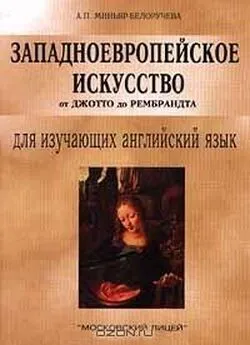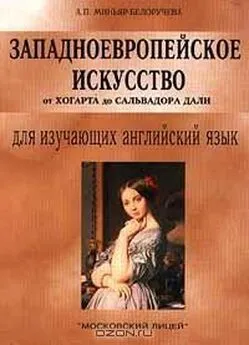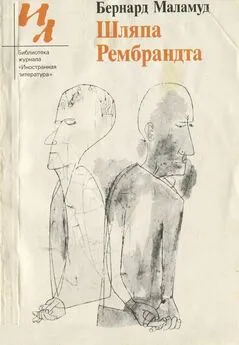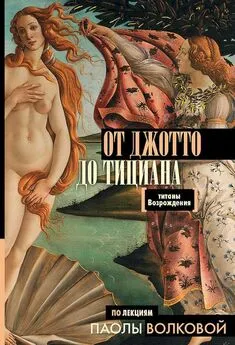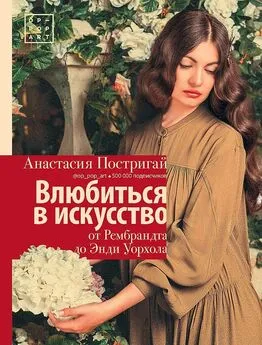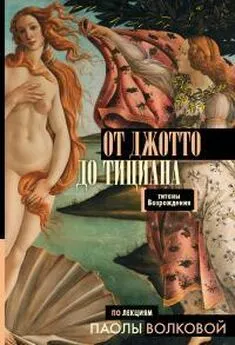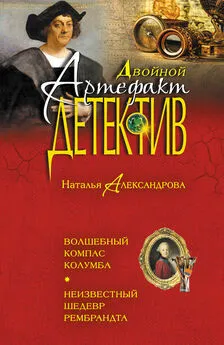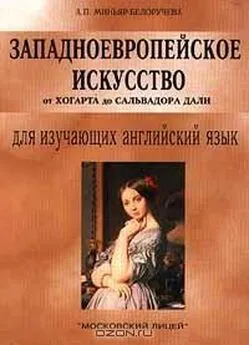А. Миньяр-Белоручева - Западноевропейское искусство от Джотто до Рембрандта
- Название:Западноевропейское искусство от Джотто до Рембрандта
- Автор:
- Жанр:
- Издательство:«Московский Лицей»
- Год:1999
- Город:Москва
- ISBN:5-7611-0181-5
- Рейтинг:
- Избранное:Добавить в избранное
-
Отзывы:
-
Ваша оценка:
А. Миньяр-Белоручева - Западноевропейское искусство от Джотто до Рембрандта краткое содержание
Тексты настоящего пособия охватывают пять веков западноевропейской живописи от Джотто до Рембрандта. Это дает возможность обучаемым приобрести не только лингвистические знания, усвоив обширный лексический материал, но и культурологические, поскольку последовательный хронологический переход текстов от одного художника к другому позволяет создать более или менее целостную картину развития западноевропейской искусства с XIII по XVII вв. Система упражнений направлена на усвоение лексического материала и развитие навыков устной речи.
Данная книга является первой частью цикла учебных пособий для изучающих английский язык и предназначена для студентов-искусствоведов, учащихся классических гимназий, лицеистов и всех интересующихся искусством.
Учебный центр «Московский Лицей»
пособие для изучающих английский язык
издание второе переработанное и дополненное
Москва -1999
Рецензенты:
И. И. Малинина кандидат филологических наук
Н. В. Васютина кандидат филологических наук
РЕКОМЕНДОВАНО кафедрой иностранных языков исторического факультета МГУ им. М. В. Ломоносова
Западноевропейское искусство от Джотто до Рембрандта - читать онлайн бесплатно полную версию (весь текст целиком)
Интервал:
Закладка:
III. Make up sentences ofyour own with the given phrases.
IV. Here are descriptions of some of Mantegna's works of art.
Match them up to the given titles…
1. This fresco is a triumph of Renaissance Classicism.
2. The Apostles stand below against the sides of the arch.
3. The frescoes represent scenes from contemporary court life.
4. Mantegna painted Christ foreshortened.
5. It is noted for the novelty of its background perspective.
6. It demonstrates Mantegna's high level of perfection.
a. Dead Christ
b. Burial of St. Christopher
c. Assumption
d. Martyrdom of St. James
e. Saint James Led to Execution
f. The Gonzaga frescoes
V. Translate the text into English.
Андреа Мантенья, крупнейший художник-монументалист падуанской школы. В своих работах он любил изображать античные памятники и развалины. В капелле Оверати Мантенья изобразил историю Св. Иакова, как реальное событие. По заказу мантуанских правителей Мантенья расписал одну из комнат дворца. Художник представил семейный портрет Гонзаго и сцены из придворной жизни Мантуи. Фреска плафона, изображающая в самом центре свода круглую галерею с людьми, смотрящими сквозь перила, является первой иллюзионистической декорацией в западноевропейском искусстве. Именно с нее начинается многовековая традиция потолочной росписи в Европе.
VI. Summarize the text.
VII. Topics for discussion.
1. Mantegna's style and characters.
2. Mantegna's artistic innovations.
Unit IV Botticelli (1445-1510)
Among the painters of the poetic current in the late fifteenth century, Sandro Botticelli stands alone in depth of feeling and delicacy of style. His concentration on line is so deep and his research into the unreal is so enchanting, that it is difficult to believe that he studied with Filippo Lippi, a follower of Masaccio. Although aloof from scientific current and criticized by the young Leonardo da Vinci Botticelli remained the leading painter resident in Florence in the 1480s and 1490s. Before him the old masters had drawn the inspiration for their works from the Bible. Botticelli delighted in myths, fables, and poetry, his nature was imaginative. The artist was the first to make his painting a means for the delight of the secular as well as the religious world.
Botticelli was closely associated with the Medici and his fortune paralleled theirs. After the death of Lorenzo, that ended the world in which Botticelli had found honours and fame, the painter was greatly impressed by the preaching of Savonarola. Soon he became an ardent disciple of this great prophet. When Savonarola demanded that bonfires should be made of the «profane pictures», he contributed many of his works of art to the bonfire pile. In his later life Botticelli turned to a religious style, and after 1500 gave up painting altogether.
Botticelli's most celebrated pictures, the Primavera (The Allegory of Spring) and the Birth of Venus were painted at a slight distance from each other in time, the first on panel, the second on canvas. Later the two paintings were considered companion pieces. Both have been interpreted in different ways. The Primavera with its ambiguous but clear meaning, is far from being the simple pagan mythology that it appears to be at first sight. No explanation of the Primavera is wholly successful. Probably the Primavera symbolizes Lorenzo Medici's real wedding in 1482.
A Christianized Venus, modestly dressed and resembling Botticelli's Madonnas, reigns in the midst of a dark grove of trees bearing golden fruit. At the right Zephyrus, the wind-god, pursues the nymph Chloris; flowers issue from her mouth. She is transformed into the goddess Flora, clothed in a flower-covered gown, from its folds she strews blossoms upon the lawn. At the left Mercury is dispelling tiny clouds from the golden apple, the symbol of the Medici family. Between Mercury and Venus the Three Graces dance in a ring. These lovely creatures are shown in transparent garments. This painting is a complex allegory. As in all Botticelli's mature works his figures are extremely attenuated, with long necks, torsos, arms and sloping shoulders. Their beautiful faces and graceful bodies and limbs seem almost bloodless and weightless, their white feet touch the ground so lightly that not a flower or a leaf is bent. The individual forms are perfectly modelled. Botticelli's representation of figures in motion is far beyond anything that preceded him and has never been excelled. The composition is based on an interweaving of linear patterns, drapery folds, streaming or braided hair, trunks, and leaves. Such a picture, both in content and style, represents a withdrawal from naturalism of the Early Florentine Renaissance.
The Birth of Venus may show the effects of Botticelli's residence in Rome in the early 1480s. Venus, according to the ancient myth, was born from the sea. Upon a sea represented without concern for space, and dotted with little V-shaped marks for waves, Botticelli's Venus stands lightly in a beautiful cockleshell, wafted by two embracing wind-gods, toward a highly stylized shore. This Venus, proportioned like the Three Graces, differs from the splendid Venuses of classical antiquity. She uses the curving streams of her long hair to cover her nakedness. She can't wait for the cloak that one of the Hours is about to spread around her. Botticelli's allegory is related to the Christian tradition with which he tried to reconcile the pagan legend. The composition has been compared to medieval and Renaissance representations of the Baptism of Christ. It may be argued that this is a rather artificial interpretation, but it is an interpretation that made sense to the fifteenth century.
Later, under the impact of Savonarola's preaching and the troubles besetting Italy Botticelli's imagery becomes less esoteric and more Christian. The best possible example is the Mystic Nativity . In order to emphasize the importance of the Madonna and Child and the relative unimportance of the humans, Botticelli has reverted to the early medieval device of disregarding scale and perspective and grading the actual sizes of the figures according to their importance; hence the Madonna is far the largest although placed apparently in the middle distance. The feature that links Botticelli most firmly with the Florentine artistic heritage is his linear perspective.
The unreality of Botticelli is a blind alley in the development of Renaissance painting, the brilliance and beauty of his line are not, and it may have influenced the pictorial style of Michelangelo.
Make sure you know the pronunciation of the following:
Sandro Botticelli; Florence; Flora; Graces; Hours; Savonarola; Renaissance; Venus; Christian; Zephyms; Chloris; Mercury
Primavera (The Allegory of Spring) – «Весна»
Birth of Venus – «Рождение Венеры»
Baptism of Christ – Крещение Христа
Mystic Nativity – «Мистическое Рождество»
I. Read the text. Mark the following statements true or false.
1. Botticelli's contemporaries admired his works of art.
2. In the Primavera Christianized Venus reigns on Olympus.
3. Flora, Mercury and Zephyrus dance in a ring.
4. Botticelli's figures are extremely attenuated.
5. In the Birth of Venus Botticelli depicted the sea as a seascape painter.
6. Later in life Botticelli's imagery becomes more esoteric and less Christian.
II. How well have you read? Can you answer the following questions?
1. What glorified Botticelli? What other painters are mentioned in this text? How were they connected with Botticelli?
2. What impact did Savonarola's preaching make on Botticelli?
3. What are Botticelli's most celebrated pictures? How are they interpreted?
4. What gods and goddesses are pictured in the Primavera ? What do they do? What is Botticelli's allegory related to?
5. What is represented in the Birth of Venus ? What gods are depicted in this painting? What do they do? Where is Venus placed? How is Venus proportioned? What differs Botticelli's Venus from the splendid Venuses of classical antiquity? What did Botticelli try to reconcile in the Birth of Venus ?
6. What does the Mystic Nativity exemplify? What device did Botticelli use to emphasize the importance of the Madonna and the Child?
7. Whose pictorial style did Botticelli influence?
III. I. Give Russian equivalents of the following phrases:
poetic (scientific) current; early in life; celebrated pictures; to give up painting; to pursue the nymph; to spread blossoms from the folds; sloping shoulders; a complex allegory; a mature work; on canvas; on panel; in the fresco; in the picture; companion pieces; lovely creatures; drapery folds; an interweaving of linear patterns; classical antiquity; to interpret in different ways; delicate faces; attenuated figures; to be aloof from; transparent garments; a withdrawal from naturalism; wafted to the shore by the wind-god; to reconcile a pagan legend with the Christian tradition; spread a cloak around Venus; to stand in the cockleshell; V-shaped marks for waves; to paint the sea without concern for space.
II. Give English equivalents of the following phrases:
ведущий художник; научное (романтическое) направление; парные работы; знаменитые картины; на холсте; на доске; на картине; на фреске; на рисунке; отход от натурализма; проповеди; разбрасывать цветы; примирить языческую легенду с христианской традицией; зрелая работа; прозрачные одежды; трактовать по-разному; легко касаться земли; перестать писать картины; стилизованный берег; галочки вместо волн; фигуры необыкновенно воздушны; преследовать нимфу; влекомая к берегу; легко стоять в раковине; утонченные лица; переплетение линий; последователь к-л.
III. Make up sentences ofyour own with the given phrases.
IV. Translate the following groups of words into Russian:
Christian – Christianize – Christianity – christianized; reconcile – reconciliation; baptism – Baptist – baptize; reside – residence -resident; preach – preaching – preacher; aloof- aloofness.
V. Arrange the following in the pairs of synonyms:
a) aloof; current; pagan; give up; to dispel; to strew; attenuated; transparent; transform; reconcile; pursue;
b) heathen; trend; distant; translucent; to disperse; to scatter; lengthy; abandon; to transfigure; chase; appease.
IV. Match the names of the gods and goddess with their responsibilities.
Venus (Aphrodite); The Three Graces; Mercury (Hermis); Zephyrus; The Hours (The Horae); Flora
Читать дальшеИнтервал:
Закладка:
